The Literary Explorer
an ongoing series by Thomas E. Kennedy and Walter Cummins
![]()
LIMMAT RUN PAST JOYCE AND NORA
In Zürich on business, I steal half a day to ride the number six streetcar to the top of Zürichberg, to Fluntern Cemetery. There, high above Zürichsee, the Lake of Zürich, and the flowing Limmat River, alongside the zoological gardens, James Joyce sits in bronze, walking stick by his leg, smoking, looking up from a titleless book that dangles open in his right hand that rests on his left knee, as he gazes westward, across two October red bushes, toward the stone that marks the grave of the great Bulgarian-Austrian novelist and Nobel laureate, Elias Canetti (1905-94), who died half a century after Joyce.
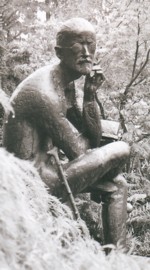
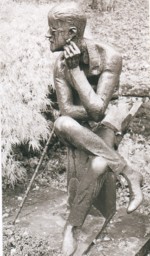
The sculpture is by Milton Hebald, and in a frame of shrub before it is a granite block inscribed with the names and dates of James Joyce (1882-1941), his wife, Nora Barnacle Joyce (18841951), their son, Giorgio (1905-76), and the latter's second wife, Dr. Asta Jahnke-Osterwalder Joyce (1917-1993), whom he married in 1954. A plaque lies flat on the grass beside it on which visitors are requested in English and German not to walk on the grave. I sidle along the edge, damp autumn Joyce mud caking the soles of my Ecco shoes, for a close-up. There is something oddly life-like about the bronze Joyce, and I think of the first line of a poem by the Danish writer, Klaus Lynggaard: "So, Jim, we meet at last . . ." Lynggaard wrote that poem at the gravesite of Jim Morrison twenty years ago, before Morrison's bust was stolen from his grave in the Parisian cemetery Pere Lachaise; no one is likely to steal the Joyce sculpture which is near life size and must weigh a ton.

It is a beautiful, peaceful place to lie, to sit, surrounded by tall pines, autumn yellow poplars, red maples and beech trees. A bird house is fixed to a tree branch a few feet above Joyce's head. I rest on the stone bench provided and light a Christian of Denmark mini, contemplating the many hours I have spent in the company of Joyce's prose, how his Portrait of the Artist as a Young Man, over thirty years ago, saved me from the living death of Roman Catholicism and American jingoism ("I will not serve that in which I no longer believe, whether it call itself my home, my fatherland, or my church: and I will try to express myself in some mode of life or art as freely as I can and as wholly as I can, using for my defence the only arms I allow myself to use -- silence, exile, and cunning.")
I recognize the fact that in life, by most accounts, Joyce was less than pleasant company and anyway would not likely have suffered my presence lightly, but it makes no difference. His contribution to the world, to my world, was enormous, the pleasure and enlightenment he has given me have abundantly enriched my life. I love him, and I love Nora, and I have dedicated more than one June 16th to a meditation on their lives as I followed the real path of the fictional Leopold Bloom strolling Dublin streets on his long day's journey back to Molly's famous yes. In life, on June 16th, 1904, Joyce took his first stroll with Nora Barnacle; "Barnacle by name and barnacle by nature," complained Joyce's father about his son's alliance with the uneducated hotel maid with whom he would spend the rest of his life. His choice of that date as the one upon which Leopold Bloom took his walk was a tribute to Joyce's love for Nora, whom Molly Bloom so closely resembles. Since 1924, many others have also commemorated that day and those characters, year after year, in many cities of the world, celebrating Bloomsday.
Joyce and Nora lived in Zürich briefly in 1904 and again in 1915-1919 when the First World War forced them from Trieste. During those four years he wrote much of Ulysses, supporting himself on private language lessons and gifts of money. When the war ended, he left, but returned frequently to consult ophthalmologists for his failing eyes and psychiatrists regarding his daughter Lucia's declining mental condition. In mid-December 1940 he again fled to Zürich, this time from France, to escape the Nazi invasion, and there he died just a few weeks later, on January 13th, 1941. Nora remained, with their adult son Giorgio, a singer, until she died in April 1951 and was buried in Fluntern as well; fifteen years later their separate graves were united there, and in 1981 (the year Canetti won the Nobel prize for literature), the Hebald sculpture of Joyce was raised. Canetti died and was buried in Fluntern in 1994.
An hour before in a buchhandel in the old town below, I bought a little guidebook from a tall, slender young woman with a large, pierced nose who told me, "There are no good guidebooks of Zürich in English. They should write one," It amuses me that the book mentions neither Joyce nor Cannetti, Freud nor Jung, Ciacometti nor Tinguely, although it does specify that there are fifteen hundred animals in the zoological gardens alongside this cemetery. It also provides the following statistics: "Zürich owns the world's largest number of public fountains (around 1300), telephones, computers, private floral decorations, and oriental carpets and also has the most Nobel Prize winners." This could not include Joyce because he never won one (which says more about the prize than about Joyce); Canetti did, although he was Bulgarian-Austrian--his novel Die Blendung (1935, tr C. V. Wedgwood, as Auto da Fe in 1946) is perhaps his most famous.
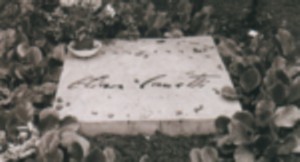
I am unable to decipher the meaning of a claim that a city has "the most" of something--the sentence is an unhandleable nonsense, and I cannot help but think how Donald Barthelme, who loved "spine-sprung sentences," would have been enchanted by it. The only literary fact the book contains is in its Zürich chronology, alongside the 18th century: "Johanan Jakob Bodmer, who translated Homer" (into German I presume) "brought Klopstock, Goethe, and Wieland to Zürich." Although it does not further identify Klopstock (Friedrich Gottlieb Klopstock, 1724-1803, the German "Christian Homer") or Goethe (Johan Wolfgang von Goethe, 1749-1832, one of the world's greatest writers), it does mention that Wieland (Christoph Martin Wieland, 1733-1813, German novelist and poet) "translated Shakespeare as a foundation for German classics" as a result of which, apparently, Zürich became known as "Athens by the Limmat."
The third to last fact in the book's Zürich chonrology is: "1968: beginning of period of unrest among young people." It does not stipulate whether the unrest ever ended, but it occurs to me that in 1968, I was twenty-four years old and that was the first time I read Joyce's Ulysses and saw Joseph Strick's film version of it as well as listening to Siobhan McKenna and E.G. Marshall's excellent recording of the Molly and Leopold Bloom soliloquies. That was also the year I sheltered a deserter from the Vietnam war in my apartment in New York, my single "substantial" act of protest against that war. I identify that act with Joyce, with his declaration from the Portrait, quoted above, and with the hero of his Ulysses, who was not a warrior like its eponymous Greek hero, but the pacifist, mild, cuckolded, humanity-loving Jew, Leopold Bloom. The power of Joyce's literary stance aided my escape from the jingoism that four years earlier had me wearing on my jacket in the chill autumn New York City streets, in the wake of the Gulf of Tonkin Resolution, a Bomb Hanoi! button. Why I wore that button, other than an unhealthy childhood diet of John Wayne and Senator Joseph McCarthy, I do not know; but as I sit on the stone bench in Flautern gazing at stone Joyce gazing at Canetti, who wrote about the psychology of fascism, I cannot help but feel gratitude to these great men who helped bring me safely through my own youthful unrest.
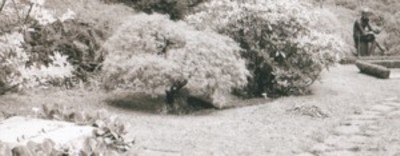
Perhaps I should not be surprised that my little guidebook says nothing about either of them. After all, this is a world whose great heroes are not really people like Joyce, but ones like Tiger Wood, a man who dedicates his life and strength to knocking little balls around an artificial meadow with a variety of expensive sticks. As Ferlinghetti says, "The end is here, but golf goes on . . ."
I ride the streetcar down the steep hills, past the university, from Zürichberg to Central and the old city. I stroll the ancient streets of fountains, antique book dealers, nightclubs, and sex shops, past walls of grafitti that proclaim Poet! and Learn to think! over a stencil of Ché with blacked-out eyes, to the Bierhalle Wolf on the bank of the Limmat river.
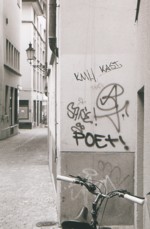

There, I celebrate my morning's pilgrimage with a luncheon plate of five different kinds of wurst and rosti, two pints of draft and a couple of Kirch schnapps. The waiter, a young man named Dirk, notices me studying a hundred franc note that depicts Alberto Giacometti (1901-66), the great Swiss sculpter; the back of the bill shows a number of his "thin man" bronzes. Dirk removes a twenty franc note from his leather money case.
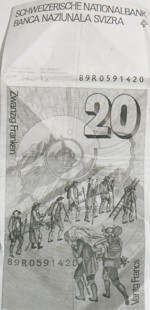
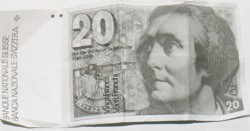
Folded into a small triangle, it depicts (I happen to know) Horace Bénédict de Saussure (1740-99), the founder of the science of geology. You can see Saussure's face in the little folded triangle Dirk holds out before me; then he flips it over and says, "And this is his wife." The obverse of the bill depicts Sausurre's historic ascent of Mont Blanc in 1787, but the little triangle into which the bill is folded reduces that scene to something which resembles a woman's bare pubis. Dirk laughs and gives me the folded bill in my change.
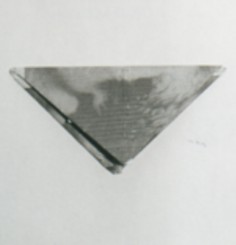
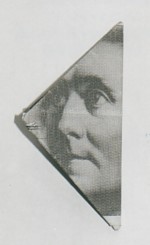
"Who was Saussure?" I ask.
"He was a popular guy," says Dirk. "Take this to America to show them. Tell them the waiter Dirk has told you this joke." I tip him and leave to walk along the bank of the Limmat toward the Zürichsee and my hotel to tend to my business in Zürich.
[copyright 2001, Thomas E. Kennedy]